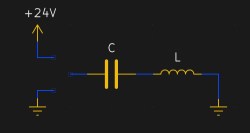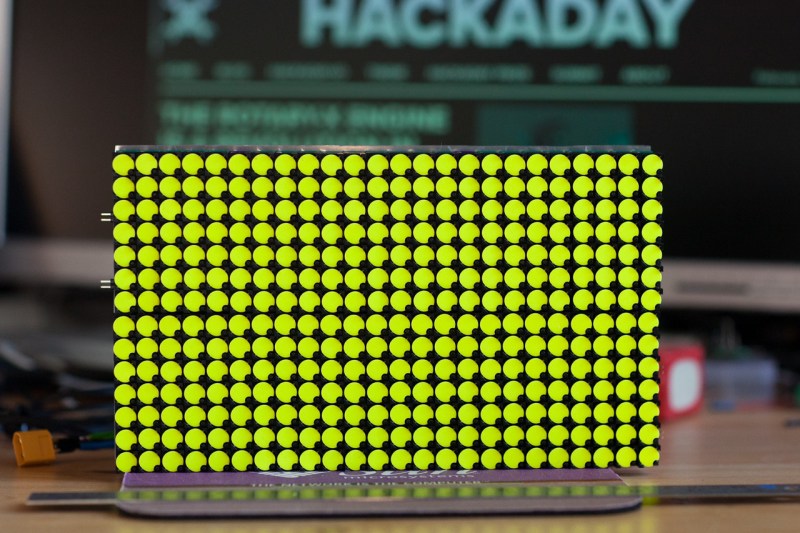Most people find two problems when it comes to flip-dot displays: where to buy them and how to drive them. If you’re [Pierre Muth] you level up and add the challenge of driving them fast enough to rival non-mechanical displays like LCDs. It was a success, resulting in a novel and fast way of controlling flip-dot displays.

The problem comes in needing to reverse the polarity of the coil to achieve both set and unset states. Here [Pierre] has a very interesting idea: instead of working out a way to change the connections of the coils between source and sink, he’s using a capacitor on one side that can be driven high or low to flip the dot.
 Using this technique, charging the capacitor will give enough kick to flip the dot on the display. The same will happen when discharged (flipping the dot back), with the added benefit of not using additional power since the capacitor is already charged from setting the pixel. A circuit board was designed with CMOS to control each capacitor. A PCB is mounted to the back of a 7-pixel strip, creating modules that are formed into a larger display using SPI to cascade data from one to the next. The result, as you can see after the break, does a fantastic job of playing Bad Apple on the 24×14 matrix. If you have visions of one of these on your own desk, the design files and source code are available. Buying the pixels for a display this size is surprisingly affordable at about 100 €.
Using this technique, charging the capacitor will give enough kick to flip the dot on the display. The same will happen when discharged (flipping the dot back), with the added benefit of not using additional power since the capacitor is already charged from setting the pixel. A circuit board was designed with CMOS to control each capacitor. A PCB is mounted to the back of a 7-pixel strip, creating modules that are formed into a larger display using SPI to cascade data from one to the next. The result, as you can see after the break, does a fantastic job of playing Bad Apple on the 24×14 matrix. If you have visions of one of these on your own desk, the design files and source code are available. Buying the pixels for a display this size is surprisingly affordable at about 100 €.
We’re a bit jealous of all the fun displays [Pierre] has been working on. He previously built a 384 neon bulb display that he was showing off last Autumn.















I guess you have to turn the music up to hear over all the clacking.
That *could* be the point.
the clacking is the best part dammit!
I wouldn’t say novel – the company I worked for was doing this over 30 years ago with flip dots and flip segments and successfully installed a large flip dot scoreboard at Lords cricket ground as well as many clocks and displays using th e7 segment versions (the biggest I personnally produced software for was a conveyor load cell display in Wales that had flip digits around 36 inches tall).
Interesting – do you remember what kind of capacitors were used? Nowadays it is trivial to throw 10µF ceramic capacitor on every dot. But I guess back then a huge array of electrolytic caps would be the most affordable solution?
It was an array of electrolytics – the station clocks were not allowed to show the wrong time (the time source was a Patek-Phillipe atomic clock) so in the event of an error, the capacitor bank was fired on each driver board to quickly clear all segments. The conveyor load cell display needed *very* large caps just to shift the segments, I can’t say they actually accelerated the digit change so much as facilitated it – I never actually got to see it installed (no camera phones then) but the construction was by all accounts impressive, with the display on top of a building, though the equipment I coded also sent the data serially to some other system that I was not privy to, beyond the communication protocol.
Wow, it looks like Lords was still working in 2005 (though looking a bit worse for wear) https://www.ucl.ac.uk/Pharmacology/dc-bits/lords10-040505s.jpg Who’d have thought it! I wonder if the one at The Oval lasted so long (same tech, different company ripped off our driver board, but their display driver hardware and PC software was no good, so I ended up down there just before xmas one year to do a complete retrofit).
Cancel that – that isn’t our display! I just looked more closely and it is definitely the wrong colour and aspect ratio! Hey ho.
That’s awesome to see it still in service decades later! Do you have any idea what the common failure mode is for these dots… capacitor failure?
The one I posted the picture of isn’t ours, I got a bit over eager when I was searching. I assumed that ours was removed when the big new one on the conference stand went in but since there is a smaller dot display that evidently post dates the new display, it is possible that it wasn’t taken out straight away. Sadly I can’t find any pictures of the ground that include the area it was installled. The Lords website only shows the swish and expensive display the rendered ours obsolete (though ours never obsoleted the ancient mechanical display that it was mounted opposite :~D)
30 FPS is the novel part, I believe.
I read it as capacitive drive enables 30 fps,. They also look like the small dots which are much simpler to get moving, so cool but nothing new as far as I am concerned.
I’m sure all the possible efficient ways of driving a flipdot display are well known by the commercial manufacturers. That doesn’t mean it’s not new in the hobbyist community.
I used the same technique for driving bistable relays in my HAM antenna tuner. That is basically the same thing – a coil that needs to be powered both ways to switch sides.
DRV_signal — || — mmmmm — COMMON
Very cool. I wonder how long a display will last like this..
Plus two Internet Points for the GPD Pocket and Tin Tin rocket. :)
Why would you hide your power-level and remove the original audio of the song from the arcade game Touhou?
https://www.youtube.com/watch?v=9lNZ_Rnr7Jc
Did you 1CC every game?
This solution or something like it might be useful in making a Braille display.
Should I feel bad knowing that the display shows Thouhou Project [ not an anime ] and is not playing “Bad apple” as it should?
Nice little hack.
I would say that you should feel bad for not knowing that it’s playing a fan made music video of a remix of the song Bad Apple!! from Touhou Project, which has been used to demonstrate the ability to play it on a variety of systems previously thought to be impossible or impractical to play it on. It’s true that the song isn’t playing, it would still cost royalties to include it.
I doubt if written permission and/or licensing is available at all, as lots of Japanese artists don’t like hard currencies getting involved.
Usually their implied/expressed terms are akin to BY-NC-SA or NC-ND or just (C) depending on circumstances, and in order of emphasis NC > ND > BY.
Looks like it could also do greyscale (yellowscale) if you put your mind to it.
Noisily though!
No way to flip the dots partway. Now if there were 4 sided flipcube displays, that would make it possible to have black and 3 shades of a color per pixel, with the cubes pivoted on one axis.
Figure out a way to magnetically spin a cube in any direction and encase the cubes inside spheres with a clear front, perhaps with a very low viscosity oil to suspend and lube them so the inside of the spheres don’t get scratched.
One more physical dimension would make it a lot easier.
Does anyone know where I could source the strips in the US? Ebay is so hit or miss.
I still want a VT340 from these!
With Sixels!
And a sponsor for the power bill…
Nice to watch, pleasing motion. Although I would pick Conway’s Game of Life to demo the display. :)
Oh, the nixie clock goes crazy at 13:38:00, why?
Little on-the-minute animation helping prevent cathode poisoning, I’d guess. The ‘seconds’ flashing would drive me nuts though!
Probably to rotate/exercise the digits that don’t change that often; ie. burn-in inhibit. It does it at 40mins too.
Supposed to run the leet animation at 1337, but off-by-one error?
in a parallel universe people are reading hackaday on something like that.
hackadot
This is a simple half-bridge driver. It is used in a lot of things, like audio amplifiers, power supplies, and even Tesla coils.
Nice build and a clever use nevertheless, but please call things by their name, instead of reinventing the wheel over and over again for every application.
You wouldn’t call a shift register a ‘cool flip-flop trick’.
But. It’s using the cap to store energy so that when the half-bridge goes low, current flows back the other way. Which is to say, it’s mimicking a full bridge with just a half. Which is to say, a cool hack.
Prove me wrong.
Exactly. That is precisely what a half-bridge does, nothing less, nothing more.